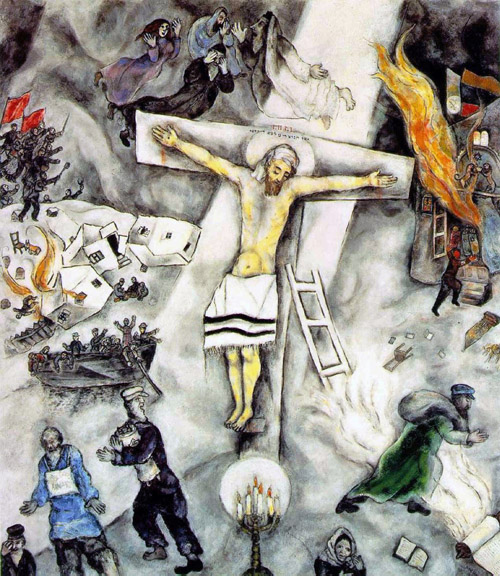
By Rabbi Michael Leo Samuel

Chagall did something that no artist before or after him—he portrayed Jesus as a martyr of the Jewish people, and it was this picture that drew considerable attention to the anti-Semitism that occurred in Russia and in Germany in the 1930s.
Instead of Jesus wearing the traditional loincloth, he is wearing a prayer shawl; instead of the traditional Christian depiction of Jesus’ crown of thorns, Jesus wears part of a tallit gadol draping over his forehead. In the place of the patriarchs and angels surrounding Jesus, Chagall portrays images of the pogroms and Nazis, pillaging and burning Jewish communities. Images of Jews attempting to flee their native countries of oppression by boat also stand out in the White Crucifixion. Mothers comforting frightened children, and other images strike the eye with no less visceral power. In the painting’s center, a peasant wears a German placard that says, “Ich bin Jude” (“I am a Jew”).
The entire picture cannot help but make Jews and Christians uncomfortable looking at this graphic work of art. If a picture can say more than a thousand words, Chagall’s painting of the “White Crucifixion” can say more than almost thousand years of history. Interestingly, Pope Francis considers this particular painting one of his favorites. The unusual juxtaposition of Christian and Jewish images provokes the imagination as good art often does.
Religious art, in particular, also needs to be viewed as a kind of visual midrash. Words, as Ludwig Wittgenstein explains, consists of mental pictures of reality. By themselves, pictures do not carry meaning, but they transmit meaning depending how they appear in clusters in accordance with a specific context. Still, mental pictures can convey one sense of visual meaning to the mind, but the actual pictures of an artist convey a much more powerful depiction of the reality the artist wishes to represent to his audience.
As I looked at this painting, I wondered: How might a fundamentalist, Catholic or Protestant person, or theologian look at this picture? Our ability to step outside our skin is vital if we are to grasp the inner world of Christians, some of whom, blame Jewish suffering on the “sins” of our ancestors.
One of Protestantism’s most illustrious thinkers, Dietrich Bonhoeffer became famous for saying on the night of Kristallnacht, “If the synagogues are set on fire today, it will be the churches that will be burned tomorrow.” Yet, who could imagine that the same man would say to one of his colleagues, “that the Nazis were merely giving what was owed to the Jews. After all, “they nailed the Redeemer of the world to the cross,” they had been forced to bear an eternal curse through a long history of suffering, one that would end only “in the conversion of Israel to Christ.”[1] Bonhoeffer’s shocking remark about the Jews did not end there. In another statement, he added:
“The Church of Christ has never lost sight of the thought that the ‘chosen people’ who nailed the redeemer of the world to the cross must bear the curse for its action through a long history of suffering…. But the history of the suffering of this people, loved and punished by God, stands under the sign of the final homecoming of Israel [the Jews] to its God. And this homecoming happens in the conversion of Israel to Christ…. The conversion of Israel, that is to be the end of the people’s period of suffering. From here the Christian Church sees the history of the people of Israel with trembling as God’s own, free, fearful way with his people, because God is not yet finished with it. Each new attempt to solve ‘the Jewish question’ comes to naught . . .”[2]
There can be no doubt that a number of Christians feel that all the persecution of the Jews are the direct result of their rejection of Jesus as “the Messiah,” “a Savior,” and as the incarnational “Son of God.” When Jews look at this Chagall’s painting of the “White Crucifixion” it is not at all difficult to see how some Christians believe this painting reflects the history of the persecuted Jew for rejecting Jesus. Yes, Chagall’s picture disturbs some Jews for that reason.
Personally, I think any Christian who accepts this interpretation of Chagall’s work has misunderstood the genius of this controversial painting. Let me propose an alternative view that some of you may find challenging. In the Parable of the Final Judgment (Mat. 25:35-40) we find a compelling moral teaching, especially if we strip the text of the Early Church’s redaction of Jesus’ words:
“For I was hungry and you gave me food, I was thirsty and you gave me drink, I was a stranger and you welcomed me, I was naked and you clothed me, I was sick and you visited me, I was in prison and you came to me. Then the righteous will answer him, saying, ‘Lord, when did we see you hungry and feed you, or thirsty and give you drink? And when did we see you a stranger and welcome you, or naked and clothe you? And when did we see you sick or in prison and visit you?’ And the King will answer them, ‘Truly, I say to you, as you did it to one of the least of these my brothers, you did it to me.”
By persecuting Jesus’ own brethren—the Jews—Jesus has taught the future generations of Christians who identify with his teachings the following lesson. Murdering the Jewish people is not only a moral crime punishable by God, it is also as though they have murdered their own savior—Jesus himself! In fact, for every Jew who suffers because Christian anti-Semitism, Jesus, too, suffers for he has witnessed the absolute perversion of everything moral that he ever taught.
Christian missionaries throughout history love to cite the following famous passage from Isaiah, when attempting to demonstrate that Jesus is the figure that Isaiah envisioned in his section on the “Suffering Servant of God.”
“He was despised, shunned by men, A man of suffering, familiar with disease. As one who hid his face from us, He was despised, we held him of no account. Yet it was our sickness that he was bearing, Our suffering that he endured. We accounted him plagued, Smitten and afflicted by God; But he was wounded because of our sins, Crushed because of our iniquities. He bore the chastisement that made us whole, And by his bruises we were healed.” (Isa 53:3-5 TNK)
Yet, as the 12th century medieval exegete and philosopher Abraham Ibn Ezra so perceptively observed, the real interpretation is not about Jesus, the suffering servant epitomizes none other than the Jewish people, who have acted as God’s Messiah to the world. While many peoples and faiths claim to be “chosen,” none have endured the pain and suffering of the Jewish people who have suffered discrimination, persecution, and finally genocide for being God’s witness to the world.
So there you have it. Jesus never lived to fulfill the expectations that Jews have hoped from the Messiah. Yet, he like so many people who came before him and after him, Jesus shared a common history in one invaluable respect: Jesus died as a martyr of his people, and for that reason alone, he is worthy of respect for his sacrifice.
In retrospect, I feel very proud that our little TBS synagogue here in Chula Vista, California, was able to offer one of the most unique programs I have experienced in all my 42 years in the rabbinate.
*
==========
NOTES
[1] Anders Gerdmar Roots of Theological Anti-Semitism: German Biblical Interpretation and the Jews, from Herder and Semler to Kittel. (Boston: Brill, 2008), p. 396.
[2] Matthew D. Hockenos, A Church Divided: German Protestants Confront the Nazi Past (Indianapolis: Indiana University Press, 2004), 21.
*
Rabbi Samuel is spiritual leader of Temple Beth Shalom. He may be contacted via michael.samuel@sdjewishworld.com
In this journal in 2012, Rabbi Samuel gave an excellent review of my book “The Good Friday Prayer” ISBN 978-1-929468-23-2. The cover of the book was Chagall’s painting White Crucificion, permission the Art Institute of Chicago. The same issues Samuel discusses above were among those discussed in the book.